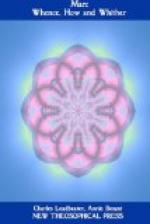And here another question of vital importance meets us. Is man’s life at present as long as it should or can be? The question is exceedingly difficult, but a negative answer seems more probable. We cannot but hope that, with a better knowledge of our physical structure, a clearer vision of the dangers to which we are exposed, more study of the laws of physiology, heredity, and of our environment, and above all, less reckless disregard of these in a mad pursuit of pleasure, wealth, and position, man’s period of mature, healthy, and best activity may be lengthened, perhaps, even a score of years. The mitigation of hurry and worry alone, the two great curses of our American civilization, might postpone the collapse of our nervous systems longer than we even dream. And if we could add even five years to the working life of our statesmen, scholars, and discoverers, the work of these last five years, with the advantage of all previously acquired knowledge and experience, might be of more value than that of their whole previous life. Human advance could not but be greatly, or even vastly, accelerated.
Moreover, we have seen that the history of vertebrates is really the history of the development of the cerebrum, forebrain or large brain, as we call it in man. This is the seat in man of consciousness, thought, and will. This portion as a distinct and new lobe first appears in lowest vertebrates, increases steadily in size from class to class, reaches its most rapid development by mammals, and its culmination in man. During the tertiary period—the last of the great geological periods—the brain in many groups of mammals increased in size, both absolutely and relatively, eight to tenfold. Dr. Holmes says, that the education of a child should begin a century or two before its birth; man really began his mental education at least as early as the appearance of vertebrate life.
But man is a mammal. This means that every organ is at its best. The digestive system, while making but a small part of the weight of the body, and built mainly on the old plan, is wonderfully perfect in its microscopic details. The muscles are heavy and powerful, arranged with the weight near the axis of the body, and replaced near the ends of the appendages by light, tough sinews. The higher mammal is this compact, light, and agile. The skeleton is strong, and the levers of the appendages are fitted to give rapidity of motion even at the expense of strength. And this again is possible only because of the high development and strength of the muscles. Moreover, the highest mammals are largely arboreal, and in connection with this habit have changed the foreleg into an arm and hand. The latter became the servant of the brain and gave the possibility of using tools.




